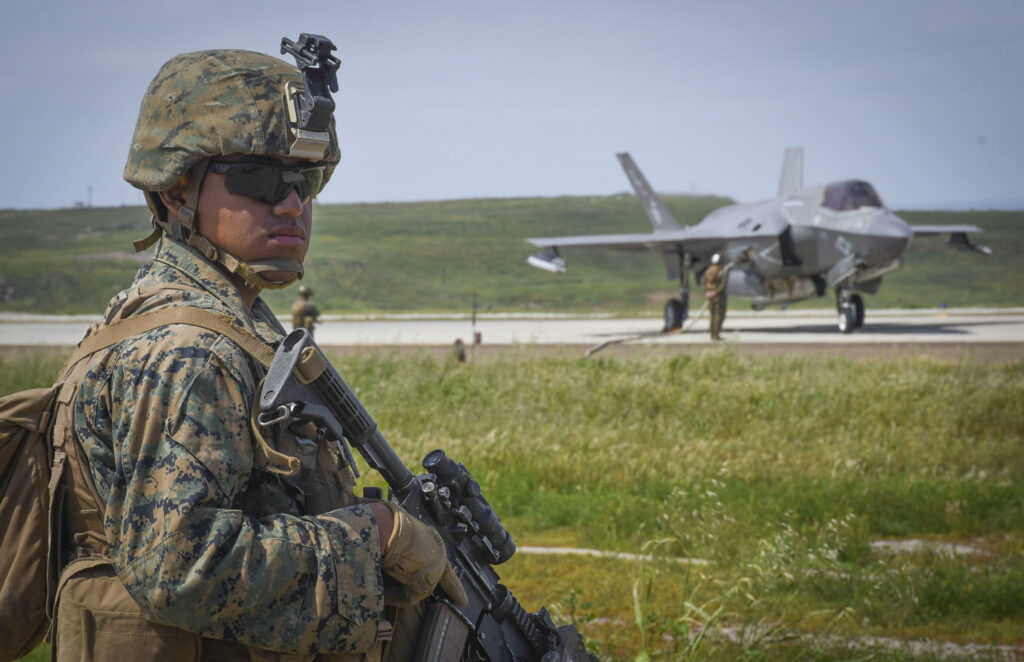
A Marine secures a perimeter near an expeditionary advanced base during Pacific Blitz 2019.
WASHINGTON: In his first public remarks since taking office in July, Marine Corps Commandant Gen. David Berger wasted no time today in proclaiming the Corps unready for confrontation with rivals like China or Russia. The Corps “is not optimized for great power competition,” he said at the Heritage Foundation. “It is not optimized to support a naval campaign. It is not optimized to support the fleet through missions like sea denial. And it is not optimized to deter a pacing threat,” he said.
That damning assessment didn’t come with the standard Washington call for bigger budgets, however. Instead, the general acknowledged that thanks to the ballooning federal deficit, the work of reshaping the Corps will have to occur within “flat or declining” budgets for the foreseeable future, a view shared by the federal government’s own estimates.
Building a new Marine Corps on a flat budget is going to require “very honest assessments of our strengths and our weaknesses,” Berger said, while “unshackling ourselves from previous notions of what war looks like and reimagining how Marines will train, how we will operate, and how we will fight.”
Berger offered a new clue to how large his ambitions are for this reset, saying he’s all about, “making large changes, not small ones,” to move the force into the future, and is ready to start tossing aside legacy equipment to create the space and funding for new unmanned systems, long-range fires, and other gear that will allow small units to operate out of ad hoc camps to support larger, joint campaigns.
“We cannot assume that today’s equipment, the way that we’re organized, how we train, how we select leaders, all of our warfighting concepts, we cannot assume they will remain relevant in the future. My assumption is they will not,” he said.
How is he going to pull this off? The general isn’t ready to say, but he’s given some clear indications that the changes are going to be fundamental and will change the types of ships needed and the ways that Marines are trained and fight.
His 23-page commandant’s guidance in July called virtually everything into question that the Corps does — from operating from amphibious ships to war gaming and equipping. So they know they’re going to change, but Marine leaders are warning it’s going to take them some time to work through how to operationalize these new ideas.
Last month, Marine leadership at Quantico said they’re launching a year-long round of wargames to find answers, while the Navy’s CNO and Berger recently signed a memo pledging to work on a joint project to hack out a new way to project power forward. The goal is to more closely align their doctrine, training, and equipping plans to complement one another, rather than the Navy simply providing lift and cover for the Corps.
If the weapons the Corps is fielding now likely won’t fit the bill, what will? Berger clearly has his eyes fixed firmly on the Pacific, and the challenges China’s military modernization and expansion present there. But while large bases in Japan, Okinawa and Guam are not likely to go away despite being within range of Chinese and North Korean medium- and long-range missiles, the Marines plan to disperse across the island-speckled region.
“Everywhere we’re going to operate in a maritime environment is going to be contested,” Berger said. “There’s no way that we’re going to travel around in complete control of all those domains. We need the force to remain inside the surveillance range, inside the weapons range, of an adversary.”
The idea is to get small units of Marines trained and equipped to establish a series of what’s being called “expeditionary advanced bases” where they can operate for several days at a time with minimal resupply. But these small bases have to be advanced enough to support the refueling of F-35Bs and other aircraft from the Navy and Air Force, while perhaps also providing precision fire support for ships at sea.
Berger said he’s looking for these bases to pack, “longer range anti-ship missiles. You could visualize them as an extension of the fleet’s magazine, augmenting air and ship-based fires. You want to add options for the fleet commander.”
Berger grew animated when talking about the small base plans he and his planners are putting together. He described them as consisting of “smaller units, distributed, mobile, that can rearm, refuel and sense forward, kill forward and move, all with a low signature.”
And in keeping with the effort underway inside both the Marine Corps and Navy to more closely align their operations after two decades of Marines fighting in Iraq and Afghanistan while the Navy patrolled hundreds of miles offshore, the general said those bases will be key waypoints for all four services.
“If you’re a captain and you’re running an expeditionary advanced base it can serve multiple functions for anybody, you don’t care. It’s not a service-centric ‘I’m sorry we only refuel Navy here.’ No. If you’re at an expeditionary advanced base you’ve serving the joint force.”
The ideas Berger and his staff are putting out there have a long way to go before becoming reality.
Col. Tim Barrick of the Marines’ Wargaming Division said recently he’s only just now growing his staff from 25 wargamers to about 150 so they can run more simultaneous exercises to work through these new forms of fighting, and Berger himself said he has to wait for the budget cycle to catch up with him.
The 2020 request is still hung up on Capitol Hill, and the ‘21 request was largely written before he took over in July. The fiscal 2022 budget is the first one in which he can really make change, but even then, he acknowledged, those changes will only come after Congress signs off on them.
In other words, the Marines desperately want to overhaul how they contribute, but it’s not going to be easy; it sure won’t be fast, and they’re not getting a blank checkbook with which to do it.
Jordan walks careful line after shooting down Iranian strikes headed to Israel
Amid Iranian criticisim, “Jordanian leaders have been very clear to portray their action as defensive and in protection of their own sovereignty rather than any act in support of Israel, and this is sincere,” an analyst told Breaking Defense.


























